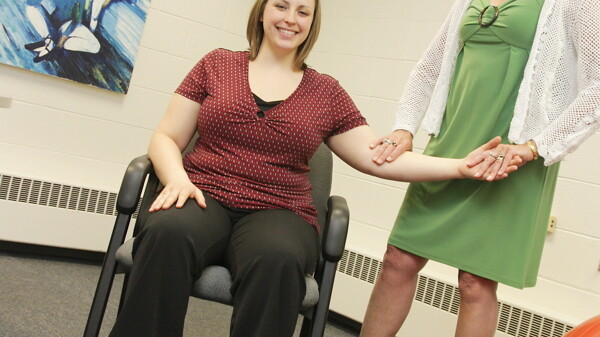Body Miseducation
How the Alexander Technique retrains you for efficiency
Maggie McCracken, photos by Andrea Paulseth |
 As I walk into Toni Poll-Sorenson’s UW-Eau Claire office, she is seated on a large, red exercise ball, perfectly poised and excited to tell me all about her passion for movement, kinesthetics, and mindfulness. These attributes are all characteristics of her specialty, the Alexander Technique, a method developed by the late Australian actor F.M. Alexander.
As I walk into Toni Poll-Sorenson’s UW-Eau Claire office, she is seated on a large, red exercise ball, perfectly poised and excited to tell me all about her passion for movement, kinesthetics, and mindfulness. These attributes are all characteristics of her specialty, the Alexander Technique, a method developed by the late Australian actor F.M. Alexander.
The Alexander Technique advocates becoming more aware of one’s own movement through a teacher-student relationship, and using this new awareness to move more efficiently. As Poll-Sorenson explained, the Alexander Technique is “a hands-on approach to re-education.”
The basis of the Alexander Technique is established in student-teacher interaction. “The teacher puts his or her hands on the student,” Poll-Sorenson explains, “particularly on landmarks where muscles, bones, and nerve endings intersect.” Using a guided touch, the teacher helps the student to understand how he or she is moving inefficiently, and how incorrect movement is causing pain and stress to the body.
Most students seek out an Alexander Technique teacher for a serious reason: physical pain. Poll-Sorenson herself became involved with the technique after a succession of surgeries, which affected her physicality as a dancer, but even non-athletes benefit from it. As Poll-Sorenson explained, “the head and neck relationship, over time, becomes compromised.”
She notices, especially in her students, a constant over-exertion and inappropriate use of the muscles we have throughout our bodies. Observing today’s young adults, it is easy to see a forward-leaning posture that is geared toward “getting somewhere in a hurry.” Leading with the head, bent at the waist, leaning on one hip, and improperly slung backpacks all contribute to the inefficient use of our muscles, and lead to severe postural problems and physical pain. The goal of the Alexander Technique is to make the student aware of the physical inefficiencies and, over time, to correct the problems. “Until they notice that this is an issue, they can’t change it,” Poll-Sorenson says.
So how does the Alexander Technique accomplish this change? Poll-Sorenson gave me a mini-session to demonstrate how a teacher goes about educating the student. She sat me down in a chair and moved my head, arms, hands, and legs into different positions. I learned a useful technique within just a few minutes of training. I apparently hold my shoulders down, rather than upward and away from my body. She explained how to adjust my shoulders (with the mental imagery of bringing my armpit to the top of my shoulder) and how to open up my back in the process. My “homework” was to incorporate this mental image into my everyday movement.
If you have any kind of regular physical pain, the Alexander Technique could be a great way to fix it. Getting massages, going to chiropractors, and doing yoga may help you feel better temporarily, but the Alexander technique focuses on correcting the problem for good. Rather than being about exercise, the Alexander Technique “is about thinking and noticing.” It is about becoming self-aware and using your own willpower and concentration to correct your physical miseducation. The Alexander Technique’s website (just add dot com), has great information, but training with a teacher is the best way to become more aware of your personal physical problems. Toni Poll-Sorenson’s at-home studio has been a sanctuary to many pain-sufferers, and is located in Menomonie. She can be reached at HumanDesign@charter.net.
As I close my article, I take a deep breath, close my eyes, and move my armpits to the top of my shoulder. Now that feels better.


















